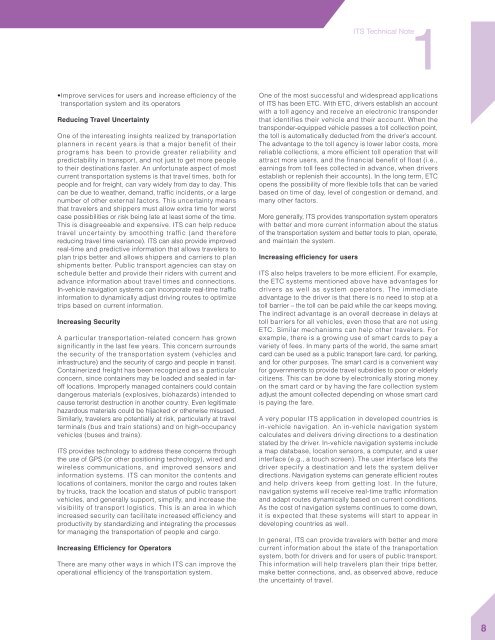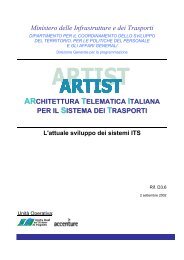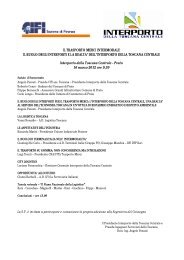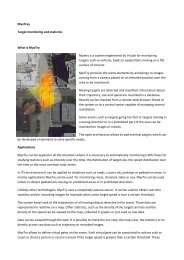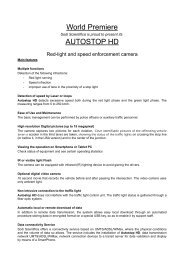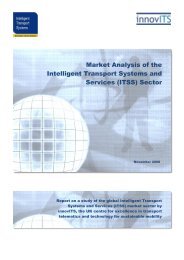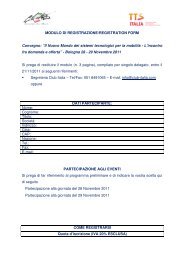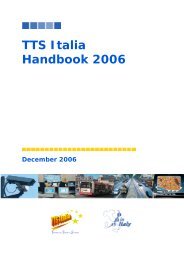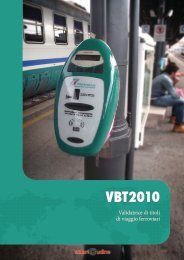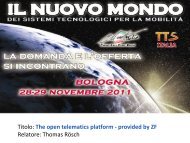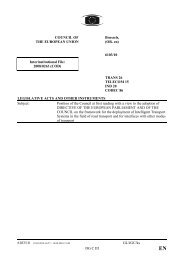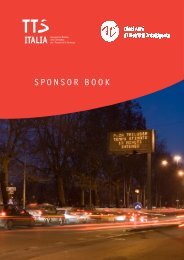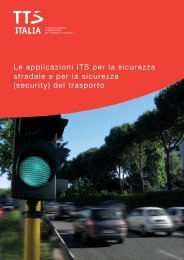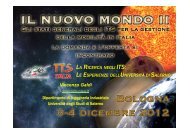ITS for Developing Countries ITS for Developing Countries - TTS Italia
ITS for Developing Countries ITS for Developing Countries - TTS Italia
ITS for Developing Countries ITS for Developing Countries - TTS Italia
Create successful ePaper yourself
Turn your PDF publications into a flip-book with our unique Google optimized e-Paper software.
1<br />
<strong>ITS</strong> Technical Note<br />
•Improve services <strong>for</strong> users and increase efficiency of the<br />
transportation system and its operators<br />
Reducing Travel Uncertainty<br />
One of the interesting insights realized by transportation<br />
planners in recent years is that a major benefit of their<br />
programs has been to provide greater reliability and<br />
predictability in transport, and not just to get more people<br />
to their destinations faster. An un<strong>for</strong>tunate aspect of most<br />
current transportation systems is that travel times, both <strong>for</strong><br />
people and <strong>for</strong> freight, can vary widely from day to day. This<br />
can be due to weather, demand, traffic incidents, or a large<br />
number of other external factors. This uncertainty means<br />
that travelers and shippers must allow extra time <strong>for</strong> worst<br />
case possibilities or risk being late at least some of the time.<br />
This is disagreeable and expensive. <strong>ITS</strong> can help reduce<br />
travel uncertainty by smoothing traffic (and there<strong>for</strong>e<br />
reducing travel time variance). <strong>ITS</strong> can also provide improved<br />
real-time and predictive in<strong>for</strong>mation that allows travelers to<br />
plan trips better and allows shippers and carriers to plan<br />
shipments better. Public transport agencies can stay on<br />
schedule better and provide their riders with current and<br />
advance in<strong>for</strong>mation about travel times and connections.<br />
In-vehicle navigation systems can incorporate real-time traffic<br />
in<strong>for</strong>mation to dynamically adjust driving routes to optimize<br />
trips based on current in<strong>for</strong>mation.<br />
Increasing Security<br />
A particular transportation-related concern has grown<br />
significantly in the last few years. This concern surrounds<br />
the security of the transportation system (vehicles and<br />
infrastructure) and the security of cargo and people in transit.<br />
Containerized freight has been recognized as a particular<br />
concern, since containers may be loaded and sealed in faroff<br />
locations. Improperly managed containers could contain<br />
dangerous materials (explosives, biohazards) intended to<br />
cause terrorist destruction in another country. Even legitimate<br />
hazardous materials could be hijacked or otherwise misused.<br />
Similarly, travelers are potentially at risk, particularly at travel<br />
terminals (bus and train stations) and on high-occupancy<br />
vehicles (buses and trains).<br />
<strong>ITS</strong> provides technology to address these concerns through<br />
the use of GPS (or other positioning technology), wired and<br />
wireless communications, and improved sensors and<br />
in<strong>for</strong>mation systems. <strong>ITS</strong> can monitor the contents and<br />
locations of containers, monitor the cargo and routes taken<br />
by trucks, track the location and status of public transport<br />
vehicles, and generally support, simplify, and increase the<br />
visibility of transport logistics. This is an area in which<br />
increased security can facilitate increased efficiency and<br />
productivity by standardizing and integrating the processes<br />
<strong>for</strong> managing the transportation of people and cargo.<br />
Increasing Efficiency <strong>for</strong> Operators<br />
There are many other ways in which <strong>ITS</strong> can improve the<br />
operational efficiency of the transportation system.<br />
One of the most successful and widespread applications<br />
of <strong>ITS</strong> has been ETC. With ETC, drivers establish an account<br />
with a toll agency and receive an electronic transponder<br />
that identifies their vehicle and their account. When the<br />
transponder-equipped vehicle passes a toll collection point,<br />
the toll is automatically deducted from the driver’s account.<br />
The advantage to the toll agency is lower labor costs, more<br />
reliable collections, a more efficient toll operation that will<br />
attract more users, and the financial benefit of float (i.e.,<br />
earnings from toll fees collected in advance, when drivers<br />
establish or replenish their accounts). In the long term, ETC<br />
opens the possibility of more flexible tolls that can be varied<br />
based on time of day, level of congestion or demand, and<br />
many other factors.<br />
More generally, <strong>ITS</strong> provides transportation system operators<br />
with better and more current in<strong>for</strong>mation about the status<br />
of the transportation system and better tools to plan, operate,<br />
and maintain the system.<br />
Increasing efficiency <strong>for</strong> users<br />
<strong>ITS</strong> also helps travelers to be more efficient. For example,<br />
the ETC systems mentioned above have advantages <strong>for</strong><br />
drivers as well as system operators. The immediate<br />
advantage to the driver is that there is no need to stop at a<br />
toll barrier – the toll can be paid while the car keeps moving.<br />
The indirect advantage is an overall decrease in delays at<br />
toll barriers <strong>for</strong> all vehicles, even those that are not using<br />
ETC. Similar mechanisms can help other travelers. For<br />
example, there is a growing use of smart cards to pay a<br />
variety of fees. In many parts of the world, the same smart<br />
card can be used as a public transport fare card, <strong>for</strong> parking,<br />
and <strong>for</strong> other purposes. The smart card is a convenient way<br />
<strong>for</strong> governments to provide travel subsidies to poor or elderly<br />
citizens. This can be done by electronically storing money<br />
on the smart card or by having the fare collection system<br />
adjust the amount collected depending on whose smart card<br />
is paying the fare.<br />
A very popular <strong>ITS</strong> application in developed countries is<br />
in-vehicle navigation. An in-vehicle navigation system<br />
calculates and delivers driving directions to a destination<br />
stated by the driver. In-vehicle navigation systems include<br />
a map database, location sensors, a computer, and a user<br />
interface (e.g., a touch screen). The user interface lets the<br />
driver specify a destination and lets the system deliver<br />
directions. Navigation systems can generate efficient routes<br />
and help drivers keep from getting lost. In the future,<br />
navigation systems will receive real-time traffic in<strong>for</strong>mation<br />
and adapt routes dynamically based on current conditions.<br />
As the cost of navigation systems continues to come down,<br />
it is expected that these systems will start to appear in<br />
developing countries as well.<br />
In general, <strong>ITS</strong> can provide travelers with better and more<br />
current in<strong>for</strong>mation about the state of the transportation<br />
system, both <strong>for</strong> drivers and <strong>for</strong> users of public transport.<br />
This in<strong>for</strong>mation will help travelers plan their trips better,<br />
make better connections, and, as observed above, reduce<br />
the uncertainty of travel.<br />
8


